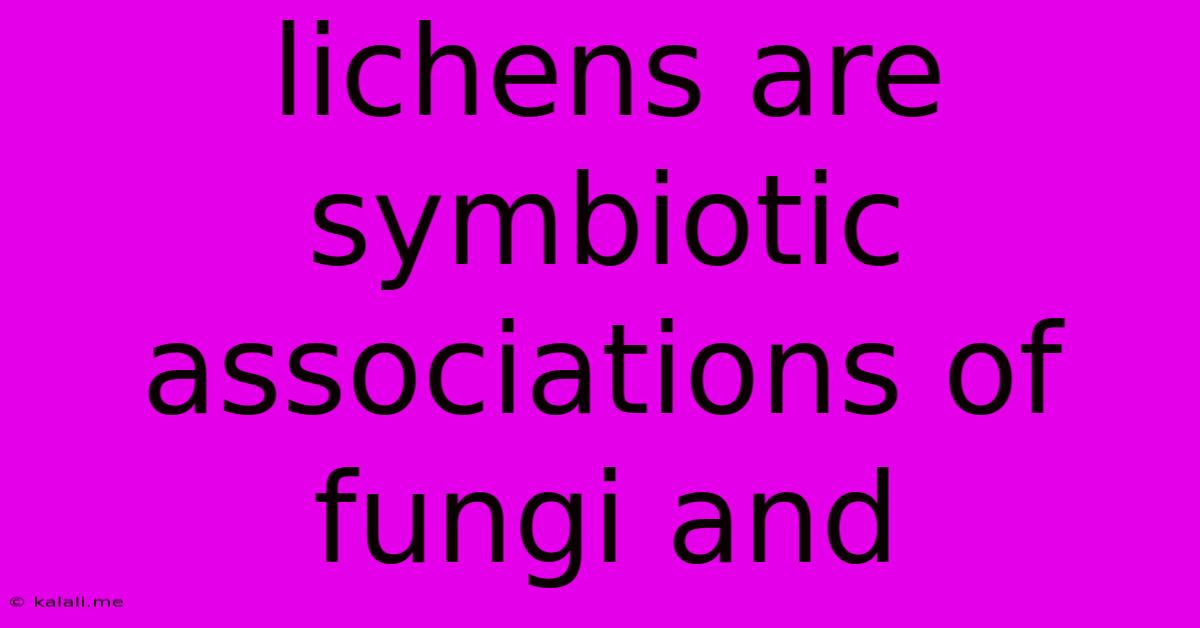Lichens Are Symbiotic Associations Of Fungi And
Kalali
Jun 15, 2025 · 3 min read

Table of Contents
Lichens: Symbiotic Associations of Fungi and Algae (or Cyanobacteria)
Lichens are fascinating organisms representing a remarkable example of symbiosis in nature. They are not a single organism, but rather a complex partnership between a fungus and a photosynthetic partner, typically algae (green algae) or cyanobacteria (blue-green algae). This mutually beneficial relationship, known as symbiosis, allows lichens to thrive in diverse and often harsh environments where neither partner could survive alone. Understanding this unique association is key to appreciating their ecological importance and widespread distribution.
What Makes a Lichen?
The core of a lichen is the mycobiont, the fungal partner, which provides structure and protection for the entire organism. The fungus forms a network of hyphae, creating a thallus (body) that can take on various forms, from crusty growths on rocks to leafy structures or even hanging, branching strands. The photobiont, the algal or cyanobacterial partner, is responsible for photosynthesis, producing carbohydrates that nourish both organisms. This intricate interplay creates a unique entity with characteristics distinct from either partner in isolation.
The Symbiotic Relationship: A Closer Look
The symbiotic relationship between the mycobiont and photobiont is multifaceted:
-
Nutrient Exchange: The photobiont provides the fungus with carbohydrates produced through photosynthesis. In return, the fungus provides the photobiont with water, minerals, and protection from harsh environmental conditions, such as excessive sunlight, desiccation, and temperature fluctuations. The fungus also helps retain moisture, essential for the photobiont's survival.
-
Protection and Support: The fungal hyphae form a protective layer around the photobiont, shielding it from environmental stresses. This protective structure also plays a role in water absorption and retention. The physical structure provided by the fungus allows the lichen to colonize a vast range of surfaces.
-
Specialized Structures: Lichens develop specialized structures, absent in their individual partners, to enhance their survival and reproduction. These include specialized reproductive structures that disperse both fungal and algal cells.
Types of Lichens:
Lichens are categorized based on their growth form:
-
Crustose lichens: These lichens adhere tightly to their substrate, forming a crust-like structure that's difficult to remove. They often grow on rocks, bark, or walls.
-
Foliose lichens: These lichens have leaf-like structures with a distinct upper and lower surface, often attached to the substrate by a few points.
-
Fruticose lichens: These lichens have a shrubby or branching structure, often hanging from trees or growing upright. They can be quite intricate in their form.
Ecological Importance of Lichens:
Lichens play significant roles in various ecosystems:
-
Pioneer Species: They are often among the first organisms to colonize bare rock or other inhospitable substrates, initiating the process of soil formation and enabling the establishment of other plant life.
-
Nitrogen Fixation: Lichens containing cyanobacteria are capable of fixing atmospheric nitrogen, enriching the nutrient content of their environment and contributing to soil fertility.
-
Food Source: Some animals, particularly invertebrates, consume lichens as a food source.
-
Air Quality Indicators: Lichens are highly sensitive to air pollution, making them valuable bioindicators of environmental quality. Their presence or absence can reflect the levels of pollutants in the air.
Conclusion:
Lichens exemplify the power and complexity of symbiotic relationships in the natural world. Their unique association between fungi and algae or cyanobacteria allows them to thrive in a wide range of habitats, playing crucial ecological roles. Further research continues to uncover the intricacies of their biology and their importance in various ecosystems. Understanding lichens provides valuable insights into the fascinating world of symbiosis and the remarkable adaptability of life on Earth.
Latest Posts
Latest Posts
-
Diodes Are Used In Electrical Power Supply Circuits Primarily As
Jun 15, 2025
-
Which Part Holds The Brains Of The Computer
Jun 15, 2025
-
Which Of The Following Is Not A Benefit Of Cycling
Jun 15, 2025
-
Greatest Common Factor Of 10 And 4
Jun 15, 2025
-
An Acid Is A Substance That
Jun 15, 2025
Related Post
Thank you for visiting our website which covers about Lichens Are Symbiotic Associations Of Fungi And . We hope the information provided has been useful to you. Feel free to contact us if you have any questions or need further assistance. See you next time and don't miss to bookmark.